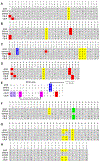Therapeutic Exploitation of GPR18: Beyond the Cannabinoids?
- PMID: 32914978
- PMCID: PMC7949482
- DOI: 10.1021/acs.jmedchem.0c00926
Therapeutic Exploitation of GPR18: Beyond the Cannabinoids?
Abstract
GPR18 is a G-protein-coupled receptor that belongs to the orphan class A family. Even though it shares low sequence homology with the cannabinoid receptors CB1R and CB2R, a growing body of research suggests its relationship with the endocannabinoid system, not only because it is able to recognize cannabinoid ligands but also because of its expression and ability to heteromerize with CBRs. In this review, we aim to analyze the biological relevance, reported modulators, and structural features of GPR18. In order to guide future drug design in this field, highlights from molecular modeling of GPR18 will be provided.
Figures








Similar articles
-
Potential metabolic and behavioural roles of the putative endocannabinoid receptors GPR18, GPR55 and GPR119 in feeding.Curr Neuropharmacol. 2019;17(10):947-960. doi: 10.2174/1570159X17666190118143014. Curr Neuropharmacol. 2019. PMID: 31146657 Free PMC article. Review.
-
Molecular and functional interaction between GPR18 and cannabinoid CB2 G-protein-coupled receptors. Relevance in neurodegenerative diseases.Biochem Pharmacol. 2018 Nov;157:169-179. doi: 10.1016/j.bcp.2018.06.001. Epub 2018 Jun 2. Biochem Pharmacol. 2018. PMID: 29870711
-
Off-target cannabinoid effects mediated by GPR55.Pharmacology. 2012;89(3-4):179-87. doi: 10.1159/000336872. Epub 2012 Mar 16. Pharmacology. 2012. PMID: 22433274 Review.
-
Towards A Molecular Understanding of The Cannabinoid Related Orphan Receptor GPR18: A Focus on Its Constitutive Activity.Int J Mol Sci. 2019 May 9;20(9):2300. doi: 10.3390/ijms20092300. Int J Mol Sci. 2019. PMID: 31075933 Free PMC article.
-
Computational Investigations on the Binding Mode of Ligands for the Cannabinoid-Activated G Protein-Coupled Receptor GPR18.Biomolecules. 2020 Apr 29;10(5):686. doi: 10.3390/biom10050686. Biomolecules. 2020. PMID: 32365486 Free PMC article.
Cited by
-
Targeting CB2 and TRPV1: Computational Approaches for the Identification of Dual Modulators.Front Mol Biosci. 2022 Feb 25;9:841190. doi: 10.3389/fmolb.2022.841190. eCollection 2022. Front Mol Biosci. 2022. PMID: 35281260 Free PMC article.
-
Development of the High-Affinity Carborane-Based Cannabinoid Receptor Type 2 PET Ligand [18F]LUZ5-d8.J Med Chem. 2023 Apr 13;66(7):5242-5260. doi: 10.1021/acs.jmedchem.3c00195. Epub 2023 Mar 21. J Med Chem. 2023. PMID: 36944112 Free PMC article.
-
Identification of Immune-Related Genes in Sepsis due to Community-Acquired Pneumonia.Comput Math Methods Med. 2021 Aug 26;2021:8020067. doi: 10.1155/2021/8020067. eCollection 2021. Comput Math Methods Med. 2021. PMID: 34484417 Free PMC article.
-
Uncovering the Power of GPR18 Signalling: How RvD2 and Other Ligands Could Have the Potential to Modulate and Resolve Inflammation in Various Health Disorders.Molecules. 2024 Mar 12;29(6):1258. doi: 10.3390/molecules29061258. Molecules. 2024. PMID: 38542895 Free PMC article. Review.
-
Cannabidiol as a Therapeutic Target: Evidence of its Neuroprotective and Neuromodulatory Function in Parkinson's Disease.Front Pharmacol. 2020 Dec 15;11:595635. doi: 10.3389/fphar.2020.595635. eCollection 2020. Front Pharmacol. 2020. PMID: 33384602 Free PMC article. Review.
References
-
- Gantz I; Muraoka A; Yang YK; Samuelson LC; Zimmerman EM; Cook H; Yamada T Cloning and Chromosomal Localization of a Gene (GPR18) Encoding a Novel Seven Transmembrane Receptor Highly Expressed in Spleen and Testis. Genomics 1997, 42 (3), 462–466. - PubMed
Publication types
MeSH terms
Substances
Grants and funding
LinkOut - more resources
Full Text Sources

